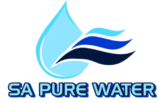There are a wide range of filter types, being used across all our installations.
Below are a list of these filters, together with some specific information on each filter that is required to know about them.
Should you require more information on any specific Filter or any of the Water Purification Process, please don’t hesitate to contact us..
FILTERS
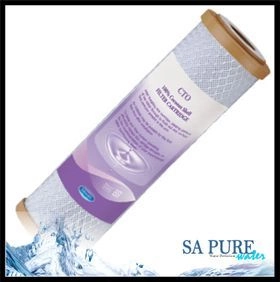
Activated Carbon Filter
Function:
Carbon filters are made from activated carbon and its specific function is the chemical adsorption of impurities and contaminants in drinking water. Carbon filters are widely used to remove chlorine, taste, odor and colour.
Features:
- 5um filtration
- Highly effective filtration of water for certain VOC’S, Chlorine, taste and odor.
- Low pressure Drop. High pressure performance.
- Extra dust holding capacity.
- Greater solids holding capacity.
- Longer service life.
- Various media are available.
- No leaching carbon ash.
Benefits
Active removal of man made and natural contaminants such as Chlorine, Benzene, Simazine, Lindane and many more.
Available in 10″ and 20″ also
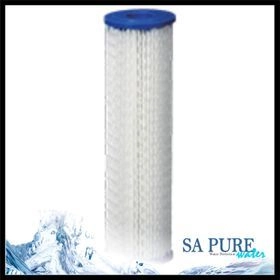
10"Std. Pleated Filter
Surface Filters (Pleated Filters) are made in a thin sheet so that only the surface captures sediment particles. These are known in the market place as “pleated filters” because of their accordion shaped pleated structure. The way the pleats are arranged gives the filter alot more surface area than normal polypropylene filters. One of their great advantages of a good pleated filter is that they are washable and reusable, more often in larger than smaller micron sizes.
To compare:
Polypropylene filters have more dirt holding capacity, and they are usually more effective if a variety of particle sediment sizes are being filtered at the same time.
Pleated filters have a much larger surface area and therefore it has more capacity for filtering particles of the same size. It is also easier to manufacture pleated filters to a specific micron size other than its counter part the polypropylene filter. As stated, they can also be cleaned and reused. Pleated filters can make up for the lack of depth by providing a much larger filter surface area.
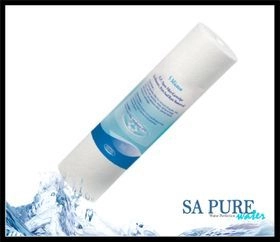
Sediment Filter
Polypropylene filter for removal of sands, silt, dirt and dust particles. Major series of high efficiency, low pressure drop, special liquid filtering cartridge.
Character:
The material meets F.D.A specification and carefully constructs to avoid potential contaminants.
Caution:
Maximum water temperature 65°C
Sediment Filters are used to remove physical particles in the water. It can also be used to remove turbidity.
Our sediment filters come in various µ (Micron) sizes. The most popular size is the 5 micron. The micron size is the hole on the pp sediment
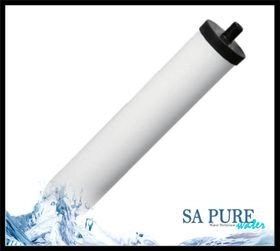
Ceramic Filter
Ceramic water filters are generally made from a fine silica powder originally formed from the cell walls of microscopic algae deposited in lake beds millions of years ago.
Ceramic water filters work by simply allowing the water to seep through tens of millions of pores in the water cartridge surface. In the process, organic and inorganic particulates too large to pass through (often anything larger than 0.5 micron) accumulate on the ceramic surface.
Contaminants that may pass through the outer surface of the water filter cartridge are likely to be intercepted within the ceramic depth. Here inside the ceramic filter, even much smaller particles can be captured.
Many ceramic filters also incorporate a silver compound into the ceramic itself, because it acts as a bacteriostatic agent to repel bacterial growth in and on the filter. A granular activated carbon core may also be added to the ceramic core to reduce chlorine and other undesirable taste & odor issues–as well as pesticides.
Ceramic filter products are available for use at home and away from home. In the house, ceramic filters can be located under the sink or on the countertop
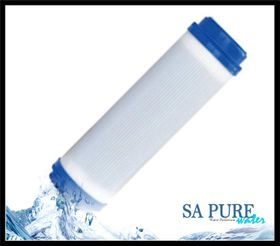
Granular Activated Filter
Highly effective filtration of water for certain Chlorine, odor and improve taste.
To keep your filter system operating effectively, replace this cartridge annually or by recommendation of your experienced water condition dealer.
Caution:
After installing this cartridge, pass 5 gallons of tap water through to flush out any carbon fine particles present in the unit.

Chlorine, Taste, Odor (CTO) Filters
“Chlorine, Taste, Odor” means that the filter will:
- Remove chlorine and
- Improve taste and odor.
- Serve as a water polisher
- Improves water clarity.
- Removes some heavy metals in water.
- Needs replacement frequently or depending on water quality and volumes.
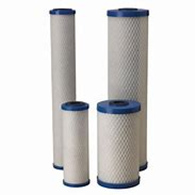
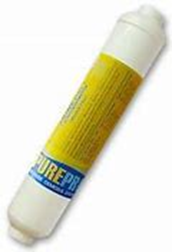
Mineral Filters
Calcium carbonate
Least expensive and largest particle size, commonly used to reduce shrinkage,
increase impact, and improve surface finish.
Dolomite
Similar to calcium carbonate with the exception that it contains more of magnesium
carbonate in structure, often used as a replacement of calcium carbonate.
Barium sulfate
Densest of all mineral fillers, used to enhance dampening and sound proofing
properties.
Talc
Magnesium silicate has platy structure often used for improving stiffness, heat
deflection temperature, and reduces coefficient of linear shrinkage.
Wollastonite
Calcium silicate, very similar to calcium carbonate, more needle-like structure.
Difficult to disperse in polymer, often used to balance the cost of glass reinforcement.
Kaolin clay
Natural aluminum silicate provides good impact modification, dimensional stability similar to talc and improves electrical properties, requires surface treatment for ease of dispersion.
Mica
Sheet silicate (phyllosilicate), flaky and platy structure, used to improve mechanical properties.
Glass beads
Most common are soda-lime-borosilicate microsphere of particle size 12–300 µm,
appear like fine powder, used for improved dimensional stability, increased
impact strength, smoother surface finish, greater thermal insulation, easier
machinability, faster cycle times.
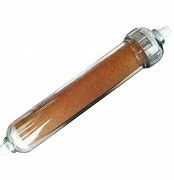
Deionized (DI) Filter
What Makes DI Water Necessary?
Deionized water is a true water blank, meaning it assumes the chemistry of whatever product is added. This has critical implications, especially for the medical industry.
When medical product manufacturers create a product, water is almost always mixed in. However, to create a chemically sound product, the water can’t contain any impurities that could potentially change the product’s chemical composition.
For example, suppose a chemist wants to make saline, or another solution injected into the body. In that case, their water needs to meet a standard called “water for injection,” which starts with deionized water. That way, when the saline formula is added to the water, it creates a replica of the solution they need.
If the water contains any impurities or metal, such as copper or lead, it will cause adverse health effects for whoever injects the product.
Other DI Water Applications
In addition to medical product manufacturing, DI water is used today in facilities across various industries, required for a myriad of reasons.
For example, a glass manufacturer may require DI water to rinse their product after it’s complete. Using tap water would result in TDS deposits (calcium, magnesium, silica) on the glass surface.
For the biotech and pharmaceutical industries, bacteria-free water is an absolute necessity. That’s because if there is any chance that a solution or the chemical mixture could end up in a patient’s body, any amount of organic content could be of great harm.
In specimen processing where surgical instruments are cleaned, deionized water is used in conjunction with a liquid or gas disinfectant and a microbial-free rinse to ensure that the instruments are free of any residuals, thereby ensuring absolute sterility. This is something that the use of tap water cannot guarantee.
Deionized water has had almost all of its mineral ions removed, resulting in bacteria-free purified water.
For many industries, like the medical and pharmaceutical industries, deionized water is the thing that helps maintain product safety and integrity.
Deionized Water
The idea of deionizing water started years ago with the scientists’ notion that water is better if it is pure.
Deionized water, also known as demineralized water, is water wherein all of its mineral ions such as sodium, iron, calcium, copper, chloride, and sulfate are removed. It is clean, safe, and it tastes great. Also, it does not contain any chemicals or harmful toxins.
Big manufacturing firms, pharmaceutical companies, and laboratories use deionized water in their experiments and products.
One can install a water filter in their home that uses direct osmosis to create deionized water. It can be costly. However, the benefits it gives can outweigh the price. Also, the system is easy to maintain since it only has a few accessories which you need to clean every month.
The water filter can be used in other places like hospitals, offices, and schools where the hard water is unsafe for drinking. Meanwhile, the ions lost in the process can be obtained through eating healthy fruits and vegetables in your diet.
Deionization is a chemical process that uses ion-exchange resins, specially manufactured, and exchanges hydrogen and hydroxide ions for the dissolved minerals. Then, it recombines again to form water.
The process of deionization can produce highly pure water, which is similar to distilled water since the majority of non-particulate water impurities can dissolve in salt. Also, deionization does not build up the scale, and the process is faster.
On the other hand, deionization cannot remove uncharged organic molecules plus the bacteria and viruses, not unless you use incidental trapping in the resin. As such, deionized water can still pose health problems in the end.
But if you use specially-made and strong base anion resins, then it can remove even gram-negative bacteria. Furthermore, one can continuously and inexpensively do deionization through electro-deionization.
Meanwhile, there are three types of deionization processes: the counter-current, co-current, and mixed bed.
Co-current Deionization
The co-current deionization pertains to the original downflow process of the water. In this process, both the regeneration chemicals and the input water enters at the top of an ion-exchange column, and both exit at the bottom.
When comparing the costs, the co-current deionization costs higher than the counter-current deionization due to the different use of regenerants.
Regenerate chemicals are diluted as it encounters the bottom or finishing resins in an ion-exchange column. As such, the quality of the product is lower versus a similarly sized counter-flow column.
Today, this process is still used by some companies. It can be maximized by focusing on the flow of the regenerants within the ion exchange column.
Counter-current deionization
Meanwhile, the counter-current deionization has two major forms that require specific engineering internals.
The first one is the up-flow columns. On this location, input water will enter from the bottom, and the regenerants will enter from the top of the ion exchange column.
Second, the up-flow regeneration. With this one, the water will enter from the top while the regenerants enter the bottom part.
In these two cases, there must be separate distribution headers that must be tuned up. The input water flow and its quality, desired product water analysis, and operation time between regenerations must be set accordingly.
Among the three types of deionizing the water, counter-current deionization is a more attractive method of exchanging ions. Chemicals or regenerants.
can be able to flow in the opposite direction towards the service flow. As such, there will be the lesser time needed versus the co-current deionization.
Furthermore, the quality of the final product can be as low as 0.5 parts per million. Indeed, there are various advantages of counter-current deionization. Some of which are requiring low operating costs and low usage of regenerants in the entire process.
Mixed bed deionization
Lastly, the mixed bed deionization is a mixture of anion resin and cation in a 50:50 ratio. This mixture is joined in a single ion-exchange column. It also contains a mixed bed demineralizers as the final water polishing that can clean the last few ions in the water before using it.
Studies show that the water produced by the mixed bed deionization through a single pass can be the purest among all water types with proper treatment.
Small mixed bed deionization units have no regeneration power, unlike big ones. Those units that are used by big companies are commercial mixed bed deionization system, and it has an elaborate regenerant and internal water distribution systems.
In this type of system, a controller operates the valves and the pumps so regenerants can mix with the anions and resins in the ion exchange column. Take note that each of these is regenerated separately and combined again during the regeneration process.
This kind of system is used only when the company requires the highest purity of water. It can achieve efficient and quality water through difficult and expensive regeneration.

